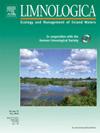Multi-year movements of potamodromous cyprinid species within a highly anthropized river assessed using RFID-equipped fishways
IF 2
4区 环境科学与生态学
Q2 LIMNOLOGY
引用次数: 0
Abstract
Movements of potamodromous fish are poorly understood, especially in large rivers, because studies often focus on fishway evaluation and diadromous species. Here, we assessed the movements of 808 fish of five potamodromous species (Barbel, Barbus barbus; Common bream, Abramis brama; Nase, Chondrostoma nasus; Asp, Leuciscus aspius and chub Squalius cephalus) over 14 years in a highly anthropized river system, the Rhine River, where hydropower plants were progressively equipped with fishways including RFID antennas. The objectives of the study were 1) to characterize long-term and large-scale individual movement patterns of five potamodromous fish species 2) to assess inter- and intra-specific variations based on quantitative movement metrics and 3) to create a typology of individuals based on their movements. Results showed that, despite high intra-specific variability, the inter-specific differences were strong enough to highlight long-term and large-scale species-specific behaviors. Breams exhibited movements that occurred essentially during spawning migration period and at the reach scale. In contrast, barbels were more active, with more movements outside their spawning migration period, showed more large-scale and downstream movements, and used navigation locks more often than other species. For this species, the maximum distance between the two furthest recorded positions at the basin scale was exceptionally high (max = 155 km). We conclude that potamodromous species undoubtedly perform large-scale movements, which are characterized by both species-specific and common features. Therefore, efforts need to be made to better consider their ecological needs and swimming capabilities when planning and designing effective fishways for the diverse range of species that move within river systems.
在一条高度人类化的河流中,使用配备rfid的鱼道评估马铃薯鲤种的多年运动
由于研究往往集中在鱼道评价和双足鱼类上,人们对双足鱼类的活动知之甚少,特别是在大河中。在此,我们评估了5种薯类(Barbel, Barbus Barbus;普通鲷鱼;鼻,鼻软骨瘤;在高度人类化的河流系统——莱茵河中,水力发电厂逐渐配备了包括RFID天线在内的鱼道。本研究的目的是:1)描述5种鱼的长期和大规模个体运动模式;2)基于定量运动指标评估种间和种内变化;3)基于个体运动建立个体类型学。结果表明,尽管种内变异性较高,但种间差异足以突出长期和大规模的物种特异性行为。鲷鱼的运动主要发生在产卵洄游期间和河段尺度上。相比之下,刺鱼更为活跃,在产卵洄游期之外的活动更多,表现出更多的大规模和下游运动,并且使用导航锁的频率高于其他物种。该物种在流域尺度上记录的两个最远位置之间的最大距离异常高(max = 155 km)。我们的结论是,马铃薯种无疑会进行大规模的运动,这种运动具有物种特异性和共同特征。因此,在规划和设计有效的鱼道时,需要努力更好地考虑它们的生态需求和游泳能力,以满足在河流系统内移动的各种物种。
本文章由计算机程序翻译,如有差异,请以英文原文为准。
求助全文
约1分钟内获得全文
求助全文
来源期刊

Limnologica
环境科学-湖沼学
CiteScore
3.70
自引率
5.90%
发文量
64
审稿时长
3 months
期刊介绍:
Limnologica is a primary journal for limnologists, aquatic ecologists, freshwater biologists, restoration ecologists and ecotoxicologists working with freshwater habitats.
 求助内容:
求助内容: 应助结果提醒方式:
应助结果提醒方式:


